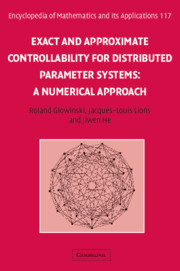Book contents
- Frontmatter
- Contents
- Preface
- Introduction
- Part I Diffusion Models
- Part II Wave Models
- 6 Wave equations
- 7 On the application of controllability methods to the solution of the Helmholtz equation at large wave numbers
- 8 Other wave and vibration problems. Coupled systems
- Part III Flow Control
- Epilogue
- Further Acknowledgements
- References
- Index of names
- Index of subjects
7 - On the application of controllability methods to the solution of the Helmholtz equation at large wave numbers
from Part II - Wave Models
Published online by Cambridge University Press: 04 August 2010
- Frontmatter
- Contents
- Preface
- Introduction
- Part I Diffusion Models
- Part II Wave Models
- 6 Wave equations
- 7 On the application of controllability methods to the solution of the Helmholtz equation at large wave numbers
- 8 Other wave and vibration problems. Coupled systems
- Part III Flow Control
- Epilogue
- Further Acknowledgements
- References
- Index of names
- Index of subjects
Summary
Introduction
Stealth technologies have enjoyed a considerable growth of interest during the last two decades both for aircraft and space applications. Due to the very high frequencies used by modern radars the computation of the Radar Cross Section (RCS) of a full aircraft using the Maxwell equations is still a great challenge (see Talflove, 1992). From the fact that boundary integral methods (see Nedelec, 2001 and the references therein for a discussion of boundary integral methods) are not well suited to general heterogeneous media and coated materials, field approaches seem to provide an alternative which is worth exploring.
In this chapter (which follows closely Section 6.13 of the original Acta Numerica article and Bristeau, Glowinski, and Periaux, 1998), we consider a particular application of controllability methods to the solution of the Helmholtz equations obtained when looking for the monochromatic solutions of linear wave problems. The idea here is to go back to the original wave equation and to apply techniques, inspired by controllability studies, in order to find its time-periodic solutions. Indeed, this method (introduced in Bristeau, Glowinski, and Périaux, 1993a,b) is a competitor – and is related – to the one in which the wave equation is integrated from 0 to +∞in order to obtain asymptotically a time-periodic solution; it is well-known (from, for example, Lax and Phillips, 1989) that if the scattering body is convex, then the solution will converge exponentially to the time-periodic solution as t → +∞.
Information
- Type
- Chapter
- Information
- Exact and Approximate Controllability for Distributed Parameter SystemsA Numerical Approach, pp. 332 - 355Publisher: Cambridge University PressPrint publication year: 2008
